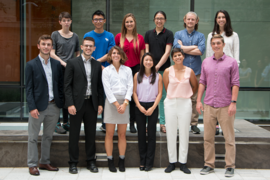Headquartered at MIT, AIM Photonics Academy is embarking on an ambitious plan to develop a technician-training program in emerging technologies, attempting to answer the question of whether an institute known for educating world-leading scientists and engineers can play a role in helping train an outstanding technician workforce.
AIM Academy is part of the American Institute for Manufacturing Integrated Photonics (AIM Photonics), focused on integrated photonics. The Office of Naval Research recently awarded a $1.8 million Manufacturing Engineering Education Program grant for AIM Academy to create a technician-certification program in collaboration with Advanced Robotics for Manufacturing (ARM). AIM Photonics and ARM are two of 14 public-private manufacturing innovation institutes created as part of a federal program to revitalize American manufacturing, collectively known as Manufacturing USA.
Until now, AIM Academy has focused on training master’s and PhD engineers, which is what companies said they needed, through summer and winter boot camps and online courses. Integrated photonics — putting light-based technology on computer chips — has diverse applications including LIDAR for driverless cars, sensors, data centers, and the internet of things. As the technology moves from the lab to production, companies will not only need highly trained PhDs to compete, they will also need a workforce of skilled technicians to fill their manufacturing lines.
Lionel Kimerling, the Thomas Lord Professor of Materials Science and Engineering at MIT, leads the AIM Academy program for AIM Photonics.
“Integrated photonics has enormous potential,” said Kimerling. “AIM Academy is developing programs now that will train workers for the jobs that are coming.” Since the integrated photonics industry is emerging, Kimerling said that the technician-training program would prepare students for the manufacturing positions that are open now, as well as jobs in photonics that will emerge in the years to come.
Both AIM Photonics and ARM have partnered with schools eager to roll out photonics-based certification programs. Pittsburgh-based ARM’s education and workforce development program will work with Westmoreland County Community College in Pennsylvania. As AIM Photonics’ education and workforce development program AIM Academy, will work with Stonehill College and Bridgewater State University in Massachusetts to develop a program specific to photonics technicians. Currently, both Stonehill and Bridgewater offer four-year degrees, but lack tracks for associate degrees or certification in the field.
The territory is new for both schools. Officials say they are responsible for preparing the future workforce, and are ready to attract a new kind of student and offer their current students access to a certification program that they believe will lead directly to jobs.
“This effort is part of a larger strategic priority to increase Bridgewater State’s ongoing expansion of educational opportunities and research in the areas of optics and photonics,” said Kristen Porter-Utley, dean of Bridgewater State University’s Bartlett College of Science and Mathematics.
Said Stonehill physics Professor Guiru “Ruby” Gu: “We envision an innovative work-learn certificate program that brings together industry, higher education and government, and creates a hub for integrated photonics in southeastern Massachusetts.”
Both Stonehill and Bridgewater officials say that the success of the certification programs begins with more hands-on lab work opportunities for students. The Commonwealth of Massachusetts has committed $28 million in capital equipment grants to AIM Photonics through the Massachusetts Manufacturing Innovation Initiative (M2I2) projects, and has already funded LEAPs (Labs for Education and Application Prototypes) at MIT and Worcester Polytechnic Institute, which will share the facilities with Quinsigamond Community College. Those LEAPs will be open to students who go through the technician-training program.
The 15-month certification program will end in student apprenticeships at local companies.
“At MIT, we are interested in deploying new technologies. We also have contacts with the companies that will use these technologies,” said Kimerling. “Because of this, we can help train the future workforce.”












